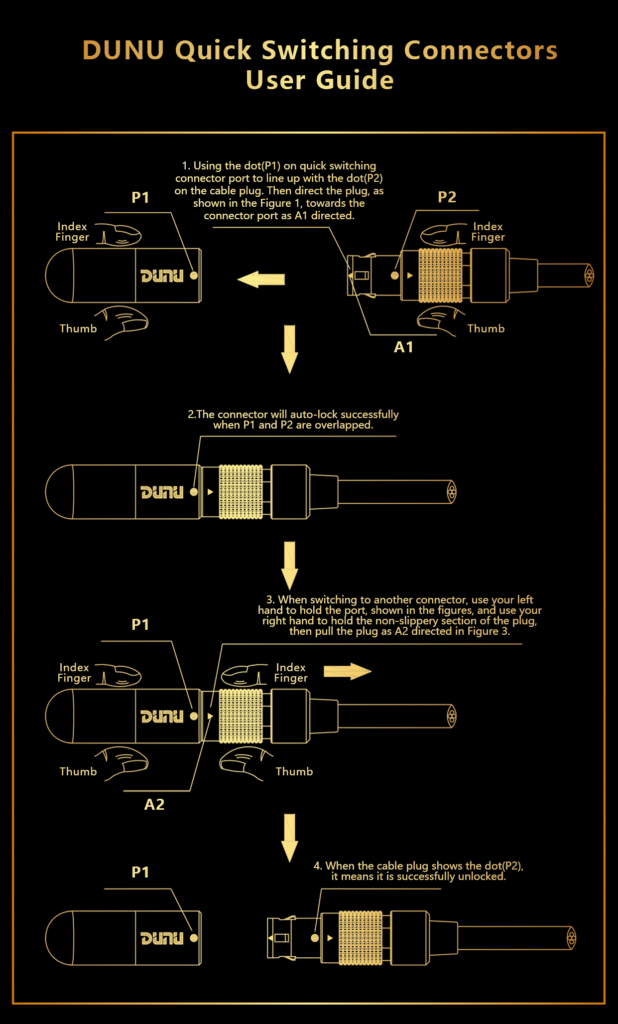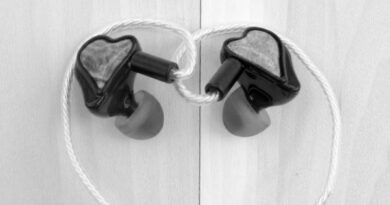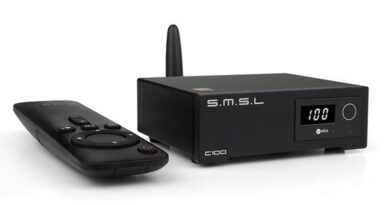DUW-02S Headphone Cable Review – Most Affordable Significant Upgrade
Optimising sound playback is notoriously a multi-faceted activity, as each single element of the audio chain impacts on the final result. Surely, some elements play bolder roles – sources and drivers – so those are typically, and justly, investigated and selected first. Then the turn comes of the other elements.
I recently spent quite some time reassessing from scratch all of my analog cables, aiming at spotting the most beneficial pairing for each, with particular regards to the IEM cables of my preferred drivers.
This article is the first of a (short) series on such topic. It covers Dunu’s DUW-02S IEM cable.
You can find it from multiple sources including Dunu’s own website of course. A reliable, and even economically convenient outlet is Hifigo, which lists them for $79,00 (and puts them on sale quite often, too).
In this Article
At-a-glance Card
| PROs | CONs |
| Solid sonic improvement in most pairing cases | Rare negative sinergy cases (only 1 spotted till now) |
| Tighter and more bodied mid bass. | Some high-mids hotness on already so-accented signatures |
| Better mids resolution and separation. | Overly tight-curved ear guides (for me) |
| Some improvement on stage depth. | |
| Livelier high-mids. | |
| Wide offering of reliable modular termination plugs. | |
| Superb lightness, flexibility, construction quality and haptics. | |
| Very good value at its current price. |
One-off introduction
These articles of mine about cables will be very short, much shorter than an average piece regarding a pair of IEMs or Headphones.
For this one first piece of the series, however, I reckon a general introduction is due. I will put it in this first article only. Boy scout word.
Let’s go.
I won’t begin to articulate on audio cables (analog and digital, by the way) making a difference or not. They do, period. If you believe the opposite you are welcome to consider me a moron. In such case do yourself a favor and quit this page immediately.
That said, cable effects can be quite varied.
Sometimes, especially in a low end configuration, the difference a cable makes is lost in the big ocean of noise and distortion, or is somehow made irrelevant by the other elements in the audio chain (from the track recording quality, to the transport, all the way to the transducers).
In some other cases, [some of] the virtuous differences cables introduce correspond to weak spots in some other component of the stack, and this results into a negative instead of a positive effect.
Thirdly, and perhaps most importantly when in conjunction with modest budget (let’s say <3000€ overall) chains, the most frequent difference a cable makes is a negative one, simply due to its bad quality – either in terms of conductive components, or even most frequently in construction quality, or both.
With all this in mind a first problem about cables is: where the heck do I get the information on which cable(s) I better avoid, and which I better get ?
Look around you: how many sources can you name whose opinions about audio gear historically lead you towards purchases which, once put on personal use, turned out to accurately match what you thought you would get based on what you had read?
Now, assuming the answer to the previous question is a number greather than 0 : how many of such sources cover the cables topic, even only occasionally ?
Good. Now you know why I had to go through almost naked hands on this, experimenting in first person, of course in small steps.
Very much expectedly I had to kiss quite a few frogs before even understanding how a frog looks like – let alone getting a princess up.
This piece is about the qualities of one particular IEM cable (more articles will follow about other models) so I won’t go into specific details about all the frogs I kissed the cables I bought (and binned).
It might however be quite interesting to recap the passages of the process I went through:
One: every single one of the <75$ IEM cables I tested (in total surely more than 150 different models, if I factor stock cables in) introduced some or a lot of distortion / negative coloration.
Two: Same can sadly be stated for quite a few more expensive ones, too :(.
Three: I identified an extremely short list (less than 5 models) of <75$ IEM cables offering at least “some” positive sonic benefit. Sadly, those come alongside other distortive side effects. Pairing such cables within an audio chain which is somehow not particularly sensitive to their particular negative effects does result in a moderate bottomline benefit. Joy.
And lastly, four: I identified an (for now) even shorter list of >75$ IEM cables offering way more obvious sonic benefits, and hardly any negative ones. Biiiiigger joy.
From all this I drew a couple of quite logical conclusions:
One: cheap cables come with statistically cheap quality. Unsurprising, isn’t it. Surely by searching a lot I might be lucky and find more gold straws in the haystack – but that’s simply not me: in Las Vegas I wouldn’t be a penny machine gambler. I am not going to spend one more euro researching “rarely decent, wonderfully inexpensive cables” – same as I won’t be looking for the next budget priced “giant killer” (??!?) IEM, or DAC, or DAP of course. I can’t be arsed, really, and that’s final.
Two: higher tier cables are a very risky but at least more rewarding gamble. There are uninspiring, and even downright crappy expensive cables, and that’s the damned risky bit. But, there are also very good ones, which do make a big difference when paired to the IEMs I love.
This article is about one of those, until now the least expensive one I found by the way.
I am not writing these articles to help manufacturers promote their products, even less I’m expecting or even accepting compensation when I do. I’m writing exclusively to share my fun – and sometimes my disappointment – about gear that I happen to buy, borrow or somehow receive for audition.
Another crucial fact to note is that I have very sided and circumscribed musical tastes: I almost exclusively listen to jazz, and even more particularly to the strains of post bop, modal, hard bop and avangarde which developed from the late ’50ies to the late ’70ies. In audio-related terms this implies that I mostly listen to musical situations featuring small or even very small groups playing acoustic instruments, on not big stages.
One of the first direct consequences of the above is that you should not expect me to provide broad information about how a certain product fairs with many different musical genres. Oppositely, you should always keep in mind that – different gear treating digital and analog sound in different ways – my evaluations may not, in full or in part, be applicable to your preferred music genre.
Another consequece is that I build my digital library by painstakingly cherrypick editions offering the least possible compression and pumped loudness, and the most extended dynamic range. This alone, by the way, makes common music streaming services pretty much useless for me, as they offer almost exclusively the polar opposite. And again by the way, quite a few of the editions in my library are monoaural.
Additionally: my library includes a significant number of unedited, very high sample rate redigitisations of vinyl or openreel tape editions, either dating back to the original day or more recently reissued under specialised labels e.g. Blue Note Tone Poet, Music Matters, Esoteric Jp, Analogue Productions, Impulse! Originals, and such. Oppositely, I could ever find and extremely small number of audible (for my preferences) SACD editions.
My source gear is correspondigly selected to grant very extended bandwidth, high reconstruction proweness, uncolored amping.
And finally, my preferred drivers (ear or headphones) are first and foremost supposed to feature solid note-body timbre, and an as magically centered compromise between fine detail, articulated texturing and microdynamics as their designers can possibly achieve.
In terms of presentation, for IEMs I prefer one in the shape of a DF curve, with some very moderate extra pushup in the midbass. Extra sub-bass enhancement is totally optional, and solely welcome if seriously well controlled. Last octave treble is also welcome from whomever is really able to turn that into further spatial drawing upgrade, all others please abstain.
Features and description
Physicals and their impacts
DUW-02S is an IEM cable, in the very common length of 1.2m.
Its conductors are high purity silver-plated OCC copper wires, arranged in Type-1 Litz configuration. Conductors are structured in 4 cores, each one protected inside a non-declared polymer sheath, brided together.
The overall result is very lightweight, soft, with great haptics. It’s also very smoothly flexibly, it doesn’t tend to “keep the shape”, and it’s almost impervious to tangling. Simply put: it’s very “pleasing” when in service.
On the IEM end DUW-02S features (fixed) terminations: either MMCX or (protruded) 0.78mm 2pin plug models are available. Either model must be selected apriori, IEM terminations can’t be swapped later.
The 0.78 2pin plug is long enough to perfectly fit Final Audio A-series connectors (known to be particularly recessed). On the flip side, when plugged onto un-recessed 2pin female connectors (e.g. those on Ikko OH10, or many other IEMs) the aesthetic effect is less than ideal, and the total connector length is on the edge of inconvenience, too.
Regarding MMCX connections, all Dunu cables I tried (3 different models, a dozen total different samples, and counting) always proved mechanically slick, convincingly firm and reliable when stuck onto the female MMCX sockets found on so many IEMs, diverse by brand and model.
A special mention deserve Intime MMCX IEMs : DUW-02S plugs into Miyabi, Miyabi-II, Yo, and Sho DD housings “better” than those drivers’ own stock cables (!). This does not happen with Intime IEMs only, indeed, but in Intime’s case it happens all the times.
One last note about the IEM end is about ear guides: I find their shape too “tight”. That’s totally subjective of course, and in facts it happens with many other cable brands/models in my case. YMMV.
On the host side, DUW-02S features Dunu’s proprietary, patented modular plug system named “Q-Lock PLUS”.

Unlike pretty much all of their lower priced competitors I assessed to date, Dunu’s Q-Lock system offers seriously firm, reliable connections, free from any risk for the cable to slip off the back of the end-plug in conjunction with an even modest pulling force.
If something, I very occasionally got the opposite: on the various Dunu cables I assessed some plugs required a little bit higher insertion force when applied to the cable, and/or the Q-Lock ring sliding felt not perfectly fluidly. In no occasion however such relative hardness turned into connection failure or impossibility, so I can’t fairly book any of this as a non-conformity.
DUW-02S comes commercially bundled with a 3.5mm TRS (single ended) Q-Lock plug. It is not possible to opt for a different standard plug when purchasing the cable.
It is indeed possible to buy extra plugs, first of all those with 2.5mm TRRS or 4.4mm TRRRS balanced analog terminations, the special 3.5mm TRRS balanced analog (fantastic option, to fully exploit Ifi’s S-Balanced architecture, e.g. on their GO link dongle), or the Digital special plug, which includes a mini DAC-AMP inside and is in its turn available either with a USB-C or a (genuine Apple certified) Lightning male plug.
Dunu’s Q-Lock modular plugs are a major benefit if I look at my preferred host gear collection. DUW-02S is the least expensive amongst Dunu cables featuring it.
Sonic impact
And finally after all this bla bla here we come to the main course. The sonic benefits brought along by DUW-02S are:
- Tighter and fuller midbass notes. Notes are better rounded, and slammier.
- Higher central mids resolution.
- Improved note and instrument separation, especially in the midrange
- Some improvement on stage depth.
- More vivid high mids.
Such benefits are in some cases just blatant, other times more modest, but they are always there pairing DUW-02S with my preferred drivers, namely
- Final B3 and E5000, vs stock final C106 cable
- Final E4000, vs stock final C112 cable
- Final A3000, A4000 vs stock final 2pin black sheathed cable
- Final A5000 vs stock final 2pin braided cable
- Intime Miyabi, Miyabi MK-II, Sho DD Halloween, Sho DD and Yo Electro, vs both Intime-M Sound and Intime-M Drum cables
- Tanchjim Oxygen vs stock 2pin cable (easy win : Oxy’s stock cable is horrible)
- Ikko OH10 vs Ikko stock 2pin cable
I feel it’s particularly worth to underline how DUW-02S makes final B3 and E5000 “sound better” on all counts in comparison with their original final C106 cables (same bundle on both models), retailing for twice the price of the DUW-02S. Ditto for A5000, in comparison with their newly designed, braided stock cable.
Even most importantly: out of all those I tried, to my experience DUW-02S is the least expensive cable bringing multiple, consistent sonic benefits to all those IEMs, systematically doing better than their relevant stock cables. All other more or even much more affordable cables I tried on those same drivers either don’t improve over stock cables, or they do, but very lightly and partially, and always introducing some (negative) side effect too.
For example: there are cheap cables improving on bass tightening, but overexciting highmids at the same time. Others nicely add on note body across the spectrm, but cut on microdynamics in the process. Etcetera.
Talking about limitations, DUW-02S tend to give high-mids some more beer while keeping a more than decent control on them. However when pairing with signatures already featuring important elevations on 3 – 4KHz they might get too hot. Intime Miyabi is an example of such a borderline situation: DUW-02S is still a good pair for me, probably won’t be for a more high-mids sensitive person. Akoustyx S6 + DUW-02S is instead beyond acceptable.
And lastly, I found one single case which I tend to consider an “absolute lack of synergy”, and that’s final F7200 + DUW-02S. Compared with stock final C071 cable pairing we have improved midbass but too hot high-mids and most central mides moved wwway too much forward. A no-no.
Considerations & conclusions
While IEM cables are not something to start bothering with until reaching a certain stability in one’s audio tastes and equipment fleet, they may indeed bring obvious sonic improvements once properly identified and paired with selected drivers.
The bad news, if you wish, is that inexpensive cables are in the overwhelming majority of the cases a pure waste of money – so much so that I tend to recommend everyone to totally disregard the topic until he/she feels ready to get involved with cables costing 75-100$ at the very least.
In hindsight, I would actually do the same if it weren’t for the (partial) need of swapping fixed-terminated 3.5mm stock cables with balanced terminated ones to enable pairing to some sources. Not that this can be considered vital: a 50$ driver will stay a 50$ driver even if better amped, or driven by a better DAC. Nevertheless, now that I identified some at-least-half-decent budget cables I basically crystallised them as my “safe cheap harbors”, and I use them when I need a “balanced swap” on a driver I’m reviewing or whatever I am not particularly committed to. A future article of this series will be dedicated to them.
The more expensive cables market does instead offer good, and very good options, if mixed and hidden amonst pure lemons. Same to what happens on any other market, after all…
Dunu’s DUW-02S is until now my least expensive find in terms of an IEM cable bringing evident sonic benefits to most of my preferred drivers, very few and occasional sonic caveats, reliable modular host termination technology, very high quality MMCX implementation, and convincing general construction quality.
At $79 plus the cost of extra modular plugs DUW-02S is not something I would recommend buying to pair with a sub-100$ driver. However, the improvement it brings to quite a few mid-tier IEMs (those I explicitly listed above and some more others…) makes for an obivous recommendation when in search of an effective way to improve on an already loved mid tier driver.
Hifigo offered me a modest “reviewer discount” on DUW-02S, as always without expectations strings attached in terms of my subsequent review contents, and I thank them for both things.
Our generic standard disclaimer.








Will these fit into IEMs like ie 600
With the recessed MMXC connection
Do you know ?
I do know, and the answer is “no, they won’t fit Sennheiser’s IE line”